Starting a dropshipping business is a legal, low-cost, and low-risk entry into online retail, with profit margins averaging 15%–20% of each item’s selling price. Unlike standard ecommerce stores, dropshipping doesn’t require buying expensive inventory, investing in warehousing, or spending time fulfilling orders.
To start a dropshipping business, you need an initial investment of $100–$500 for platform fees and marketing, a computer with internet access, and plenty of time for research and setup (along with five to 10 hours a week in ongoing management of your new operation).
Most dropshippers report reaching profitability within six months. There are many variables involved in the trajectory of your store, but it’s reported that it takes roughly 12 months of dedicated effort to have an operation that can replace your full-time income.
Just starting out? Learn more about the dropshipping business model and how it works.
Here’s how to start a dropshipping business in 10 simple steps:
Step 1: Develop a Competitive Business Concept
The first step is to develop a concept that you center your brand, content, and product collection around. It can grow out of something you’re passionate about or be based solely on sales trends.
As a dropshipping seller, you can brainstorm ideas, experiment with different concepts, and fine-tune your business as you go. One of the biggest advantages of starting a dropshipping business is that you aren’t tied down by expensive inventory, so changes can be made at any stage.
During this step, keep in mind that focusing on niche products can make marketing more effective, help your website rank high in topic-specific search results, and strengthen eventual buying intent.
Also ask yourself how your business concept and related offerings will solve problems for your buyers. This approach can help you achieve an edge in the competitive ecommerce world by creating meaningful connections between your customer base and your products.
Conduct Product Research
Whether you’re niche-focused or casting a wide net, you’ll want to do some product research to get an idea of what’s selling. Seek out products and categories that are trending to gain traction for your dropshipping business.
Not sure where to start? Here are the metrics you can use to assess the potential of a product, plus helpful tools and resources to get the data you need:
A new dropshipping business isn’t ideal for filling a gap in the market. By identifying which products are already selling well, you’re ensuring that there is a demand for your offerings.
To determine which items are selling well, use these resources:
- Shopify’s list of trending products can be a valuable jumping-off point for your research. It’s a frequently updated resource that includes vital stats on global order growth, growth of related sellers, and geographical relevance for each item.
- Amazon’s Best Sellers Lists allow you to see which products are performing best in each category, so you can hone in on what your niche market is buying.
These lists can be viewed by broad category—such as Camera & Photo Products—or refined to focus in on more specific sectors like darkroom supplies. This can help you model your concept and identify specific, promising products.
Learn more about Amazon trending product research and how to use Amazon keyword tools in our guide to the best products to sell on Amazon.
Through keyword data, you can see how many searches have been made for a term in the past day, week, month, or longer—which indicates product demand and success potential for your concept.
General keywords (“camping supplies”) can measure consumer interest in a category, while more specific keywords (“portable camping stove”) can give you an idea of product popularity.
Try these online tools for your keyword research:
- Google Ads’ Keyword Planner provides insight into how frequently your keywords are searched and allows you to compile data into a usable advertising plan (although it only displays a range of search volume—i.e., 10K–50K searches—rather than specific figures).
It has helpful features that can gauge competitiveness, recommend successful related terms, and show how search volume could play into your advertising budget.
- Ahrefs Keyword Explorer supplies thousands of relevant keyword ideas with accurate search volume, a user-friendly keyword difficulty score, and advanced metrics like cost-per-click (CPC), bounce rate, and parent topics.
From a keyword search on Ahrefs, you can also see how each term performs based on location, plus which competitors are ranking in the results pages.
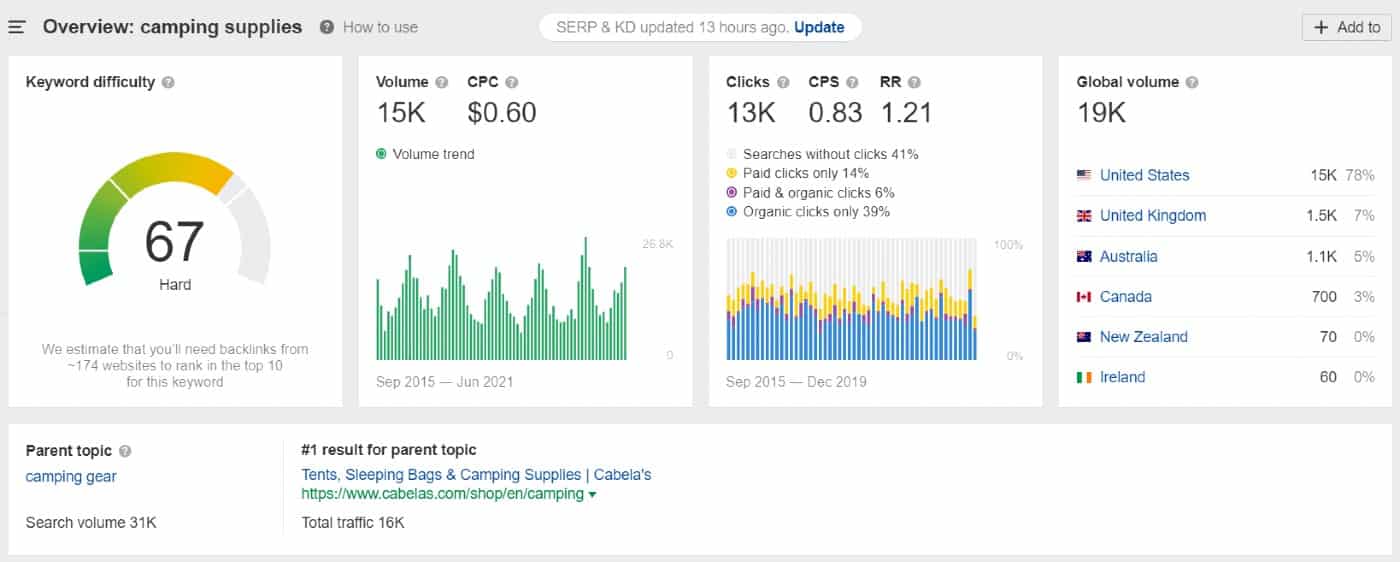
Ahrefs’ Keyword Explorer shows that the term “camping supplies” boasts 15,000 monthly searches in the US alone (Source: Ahrefs)
Another aspect of keyword research is getting a feel for how your search terms’ performance has changed over time.
Trend data can demonstrate a product’s potential for long-term success or provide ideas that could be temporary hot-sellers. The beauty of dropshipping is that your offerings can more easily adapt to changing demands than the inventory of a standard retail store.
Analyzing search trends can also give insight into the seasonality of a product. If an item’s popularity waxes and wanes through the year, it might be necessary to diversify your offerings or skip it altogether.
This free tool is our recommendation for trend analysis:
- Google Trends presents search data through graphs showing interest over time. It allows users to see results on a customizable timeline and refine by search channel—such as web search, image search, or Google Shopping search.The tool also ranks “rising” keywords and suggests related topics to explore. Plus, it’s equipped with a comparison feature to weigh the stats of multiple terms against each other.

The performance of the keyword “camping supplies” over the past five years shows a heavy seasonal impact. (Source: Google Trends)
Step 2: Analyze Your Competitors
Successful competitors provide valuable insight into what works in your market, and that info can help you construct your own plans.
Plus, it’s important to understand how competitive your chosen niche may be. It’s estimated that only 10%–20% of dropshipping startups are successful, so it’s best to choose a niche that isn’t oversaturated.
Here are some effective methods to research your competitors:
- Check out search engine results pages (SERPs): Search for your own keywords on Google and assess which sites are ranking highly. Make sure to explore image search and shopping results as well as standard web results. From here, you can identify who your top competitors will be. Take note of their site layout, product range, pricing, item descriptions, shipping strategy (including cost and delivery speed), and advertisements.
- Use social media: Instagram, Facebook, TikTok, and even Twitter are effective marketing platforms that often receive a lot of funding and attention from online stores. Find your competitor’s accounts and evaluate how they manage their socials—including response time, customer engagement, feed layout, post frequency, and affiliate influencers. Make sure to follow their accounts to stay up-to-date. Alternatively, you can search Facebook’s Ad Library for sellers promoting goods within your niche. This can be a helpful resource for planning your own marketing strategy.
- Sign up for mailing lists: By subscribing to your competitor’s regular emails, you’re getting crucial information sent right to your inbox. Keep an eye on the updates you receive to gauge things like frequency, copywriting tone, and promotion models (like sales and coupons).
Google’s algorithm penalizes sites for copying content. Seeking inspiration from similar stores is a smart strategy, but don’t reuse photos or text from your competitors. This bad practice can hurt your search engine rankings and lead to legal consequences.
Step 3: Name & Brand Your Dropshipping Business
Once you have an idea of the types of products you’re going to sell and who you’re marketing to, formalize your concept by choosing a name and brand for your dropshipping store.
Especially because you’re selling products online, marketing your business on popular social media channels like TikTok and Instagram as well as through search engine marketing will play a big role in your success. Take this into consideration when choosing your brand name.
Select Your Business Name
Your dropshipping business’ name should reflect the products you sell or the customers you’re selling to. Ideally, your name will be memorable, brief, and easy to spell. If you’re not sure where to start, Shopify’s business name generator can help spark ideas.
Check for Available Domains & Social Media Handles
As if choosing a business name wasn’t hard enough, you also need to make sure there’s a corresponding domain name and social media usernames available.
Selecting a business name that is already taken could put you at legal risk. Sharing a name with other businesses is also confusing for customers and makes it harder to market your store.
When you have some possible name ideas, search available domains through a domain provider like Google, GoDaddy, or Bluehost. For social media handles, you can search within the platforms you think you’ll want an account with.
Learn more about domain names:
Create a Brand Concept
Now that you have your dropshipping business’ name, fully flesh out your concept with the following:
- A logo: The Best Sites for Logo Design (Free & Paid Options)
- Color scheme: How to Pick a Website Color Scheme
- Typography: How to Pick a Font for Your Brand
If you’re artistically inclined or have an interest in marketing, this step can be a lot of fun. If this doesn’t sound like your cup of tea, you can enlist help from professionals on sites like Upwork. Alternatively, many ecommerce platforms have free resources and themes that can help guide you through this process.
Step 4: Source Products From Reliable Suppliers
Sourcing products is one of the more time-consuming steps in starting a dropshipping business, but has a huge impact on your profits—so it’s worth committing a lot of time and attention. You’ll need to consider each product and vendor for total viability.
Consider these factors as you review potential dropshipping products and suppliers:
- Item Popularity: An item’s previous sales volume is an easy metric to find on most dropshipping marketplaces. Although you may be able to market less popular products effectively, hot sellers are usually safer bets.
- Profitability: Your credit card processing fees and shipping costs will take a consistent bite out of your profits, so evaluate each item’s wholesale cost and suggested pricing for potential profitability. Keep in mind that you can increase an item’s markup to make your sales more profitable or decrease it to better attract buyers.
- Item Quality: One of the biggest drawbacks of dropshipping is that it’s hard to gauge the quality of your goods. You can order a sample for yourself to get hands-on experience, but this can become overly time-consuming to do for an entire store’s worth of offerings. Most dropshipping sellers rely on marketplace supplier ratings and sales numbers when judging the quality of an item.
- Location: A supplier’s location will have an impact on shipping cost and delivery speed—important factors in the customer’s buying decision. Many dropshipping vendors are based in China, so try to work with vendors who provide ePacket shipping for fast, trackable deliveries.
- Supplier Reliability: Until you’ve worked with a supplier, it’s difficult to assess how reliable they will be. However, most dropship marketplaces are strict with their vendors and won’t keep a vendor with ongoing service and quality complaints. Additionally, supplier reviews are usually accurate and helpful resources.
- Return Policy: Most dropshipping marketplaces aim to avoid returns and handle most problems via no-return refunds. However, each marketplace operates differently, so you’ll want to check out the return policy and process for each platform (or direct vendor) you use.
The two main ways to source dropshipped goods are through dropshipping marketplaces or direct-source suppliers. Here’s an in-depth look at each option:
For new sellers, using marketplaces is the easiest path to starting a dropshipping business. These platforms automate the dropshipping process and make it easy for entrepreneurs to both build and operate a business. They do this by directly integrating with ecommerce platforms, which allows you to:
- Easily search for and source goods to sell
- Add listings to your store with a single click
- Display stock availability to avoid backorders and customer service issues
- Automatically forward orders to be shipped to the correct suppliers
- Automate shipping confirmations to update customers
- Pay the wholesale cost upon shipment (after the buyer has paid you for it)
The most impactful of these benefits is the ability to find products with ease. Platforms like DSers host thousands of suppliers—ranging from independent manufacturers to individual wholesalers and aggregate vendors such as AliExpress.
In total, DSers connects store owners with millions of products to choose from. You can search the entire catalog by item, category, vendor, location, or by useful metrics like sales volume.
Dropshipping marketplace profit margins run about 15%–20% of the selling price, which is a healthy profit for a low-cost, low-risk selling method. The downside of using these marketplaces is that your competitors can access the same products.
Some marketplaces charge monthly or per-transaction fees to access their platform, but most offer a free starter plan to help you start a dropshipping business without any upfront costs.
Top-rated Dropshipping Marketplaces
Dropshipping Supplier | Starter Plan Cost | Best For |
|---|---|---|
Free | Shopify sellers. Lists products from thousands of individual vendors and AliExpress. | |
Free | All sellers. High-volume, import dropshipping marketplace works with most ecommerce platforms. | |
Free | All sellers. Marketplace for US-based suppliers with fast shipping and turnkey programs. | |
$24.99/month after 30-day free trial | Shopify and Volusion sellers. Lists millions of products from US- and import-suppliers. | |
Free | All sellers. Fast shipping on goods from US and European suppliers. | |
Free | All sellers. Lists a collection of trendy goods from US, European, and Canadian suppliers. | |
Free | All sellers. Print-on-demand (POD) supplier lets you add designs to products to print and ship on order. |
After the startup phase, many dropshipping businesses use more than one marketplace to source their products. You can list and sell goods from multiple marketplaces using plug-and-play integrations on platforms like Shopify and WooCommerce, which helps diversify your offerings.
Seasoned dropshippers and industry experts agree that dropshipping marketplaces are ideal for startups or side gig and part-time sellers. However, to develop a more profitable, long-term venture, sellers need to look at more direct sourcing options, which we’ll look into next.
As order volume scales and your dropshipping business develops, higher profit margins are attainable by sourcing your own dropshipping partners directly.
One way to do this is to form relationships with vendors you’ve previously used on dropshipping marketplaces. If their products consistently perform well with your customer base, it’s worth seeking outside arrangements that are more profitable for both parties.
Once you find your product niche and establish relationships with suppliers, this can turn into selling “white-label” products. These are goods that are manufactured and fulfilled by other vendors but branded to appear as though your own company produced them.
If you prefer to source wholesale suppliers through other means, here are some resources to use:
Recommended Sources for Wholesale Suppliers
A supplier-discovery database of over 6 million products. It’s used to source goods from US manufacturers across all types of industries. | |
An import/export data hub that can be used to discover suppliers or directly import wholesale goods. | |
Buyer’s Markets | Industry-specific buyer’s markets are a great place to discover all types of suppliers—especially small manufacturers with limited marketing resources who may be open to dropshipping partnerships. America’s Mart, Dallas Market Center, and NY Now are popular digital marketplaces that also host frequent in-person market events. Alternatively, search online for a buyer’s market near you. |
Some private-label manufacturers, including cosmetics and personal care lines, offer their own branded products to dropshipping sellers. |
Most manufacturers and importers have average order volume thresholds, so they’re unlikely to work directly with startups. For most new dropshipping businesses, direct sourcing is a goal to have on the radar for future development.
Plus, unlike the dropshipping marketplaces, the above resources don’t offer plug-and-play connectivity. To work directly with suppliers, you’ll need a more hands-on approach in terms of adding products to your website and forwarding orders for fulfillment. That is usually done through ecommerce management software, which adds to your labor requirements and operating costs.
Step 5: Plan Your Dropshipping Website Strategy
To put your dropshipping business into action, you need an accessible, user-friendly, and traffic-driving ecommerce website. For this step, you’ll need to plan a model for your site.
Choose Between a Product-focused or Content-focused Site
Is your business concept more product-focused or content-focused? This differentiation is important because some ecommerce platforms are better for content-rich sites, while others cater to product-focused businesses. Plus, this model will play into your advertising strategy, which we’ll discuss later on.
Here’s an overview of these two models:
These sites take on the usual storefront-style design to sell goods, and they’re the simplest choice for new dropshippers.
Product photos, descriptions, and specs play the leading roles, and items are grouped by category or promotion (such as featured items, new arrivals, or sales). Product-focused stores usually have an FAQ section that clarifies shipping details, return policy, and other relevant info. An “About Us” page is also common—this sheds light on the company’s history and philosophy.
Other than those written sections, additional content is sparse on product-focused sites. This structure is best for general dropshipping stores that sell a wide variety of goods, as well as simple niches that don’t require prerequisite knowledge.
For example, a dropshipping store that sells socks would be a good candidate for a product-focused model. On the other hand, a site selling bird-watching equipment would benefit from publishing educational content to bolster its listings.
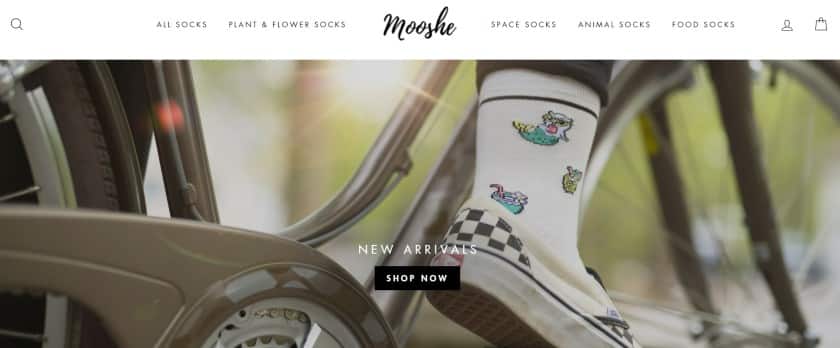
This product-focused dropshipping site leverages simple, eye-catching visuals with minimal written content. (Source: Mooshe)
Product-focused stores can still use content to garner engagement and market themselves, but it often exists offsite. Maintaining an active YouTube channel and social media presence are great ways to publish content, along with sending regular, informative email updates.
Some dropshipping business concepts benefit from having a store structured around applicable content. This is often the case for niches that have an engaged community or require prerequisite knowledge to use—like infrared saunas, custom mechanical keyboards, or rock climbing gear.
Informational content like blog posts, recipes, instructional videos, and user highlights take center stage in content-focused stores. This material supports product listings by elaborating on how your items are used and what benefits they can provide.
A content-focused business provides plenty of fodder to support your marketing efforts. While shoppers will find your store in search of products, this model can also gain traction with viewers seeking information rather than goods—boosting your site’s traffic and encouraging future sales.
Plus, informational content is heavily weighted in Google’s algorithm, so content-focused stores have the potential to rank higher in search results.
These sites also feature standard product listings grouped by category or other filter options for more direct sales.

This content-focused site sells saunas through informational blog posts, eBooks, videos, and educational FAQs—all accessible from the store’s homepage. (Source: Celebration Saunas)
With a general plan for your site in mind, the next step is to get the right tool to build it.
Step 6: Choose Your Ecommerce Platform
To easily build a site with shopping cart and payment processing features, you need an ecommerce platform. We recommend Shopify as the best overall ecommerce platform for small businesses.
You can use Amazon to sell your dropshipped items, along with other large marketplaces like Walmart and eBay—but proceed with caution. These marketplaces have costly seller fees, strict shipping deadlines, and customer service requirements.
Many dropshipping sellers do well on these platforms, but they’re not startup-friendly by any means. We recommend that you get to know your suppliers and the process first on your own site, then branch out to seller marketplaces.
The best platform for your dropshipping venture will depend on your store’s model and your plan for sourcing suppliers.
Here are some of the top platform options for dropshippers:
Step 7: Build Your Dropshipping Site
Building an ecommerce website starts with laying the groundwork— like setting up payment processing, connecting a domain, and designing a layout.
If you’ve chosen Shopify as your ecommerce platform, check out our guide to setting up a Shopify store for detailed instructions.
If you’re using another ecommerce platform, refer to the provider’s website for tutorials, FAQs, and helpful articles. Most platforms offer helpful customer support or even free setup assistance sessions to make this step as easy as possible.
These resources can help you sort out all of the aspects of your store—from integrating your shipping strategy to listing your products.
No matter where you’re setting up shop, building your site will start with:
- Choosing a template or theme
- Customizing your pages (use the color scheme and typography you chose earlier)
- Connecting your domain name
For more tips on setting up your basic pages, see our guide on making a small business website and what makes a good website.
Once you have the theme and main pages of your site set up, there are some critical details that may apply differently in a dropshipping business.
Here are some areas of your site to focus on:
Even though the products you’re sourcing likely come with product descriptions from the manufacturer or dropshipping supplier, it’s crucial that you write your own product descriptions if you’re selling on your own site.
Copied product descriptions can harm your website’s chances of ranking in search results. And, most pre-supplied product descriptions simply list features and product specs instead of clearly communicating benefits.
See our guide and free worksheet on crafting product descriptions to learn more.
Every online store needs user-friendly, affordable, and secure payment processing— dropshippers are no exception. In fact, choosing the right payment processing methods can help increase conversions and decrease shopping cart abandonment by allowing customers to checkout with just one or two clicks.
Digital and mobile wallets like Apple Pay are the most popular payment methods for online shopping, followed by credit and debit card payments.
However, buy now, pay later (BNPL) financing is increasingly popular. Adding a BNPL payment method to your online store can encourage more sales and higher average order values.
Most popular ecommerce platforms come with pre-configured payment processing that you simply need to enable. Often, there are also options to enable mobile wallet payments and connect other processing options like PayPal and BNPL financing partners.
Even though you won’t be fulfilling orders yourself, most suppliers will charge you the cost of shipping their products to your customers.
At this stage you’ll need to determine which transportation choices you’ll offer, how those costs fit into your margins, and what shipping charges the customer will pay.
The top reason for shopping cart abandonment is a surprise shipping fee at checkout, so the way to combat this is to be transparent with your shipping costs. Be upfront with all shipping charges and clearly list any fees before shoppers reach the checkout stage.
Dropshipping sellers can choose from a variety of strategies to manage shipping costs on their sales, such as offering:
- Unconditional free shipping and absorbing the costs into your margins
- Unconditional free shipping and incorporating shipping costs into your prices
- Conditional free shipping on a minimum order value
- Conditional free shipping on products with a high markup
- A low, flat-rate shipping fee and covering any excess costs yourself
- A shipping fee equal to the exact cost of shipping
To see how each of these options can work in your store, read our guide to profitable shipping strategies.
Your customers need a means of contacting you to handle questions, order modifications, returns, and other inquiries. It’s important to offer high-quality customer service to gain loyal customers, get positive customer feedback and reviews, and minimize the need to issue refunds.
Make sure to include a “Contact Us” page that is accessible from anywhere on your site. From there, list at least one contact option (the more you can offer, the better). These can include:
- Contact form: The simplest channel for feedback is a contact form. Your form should have fields for the customer’s name, email address, and a personal message.
- Email address: Avoid using your personal email address and opt to set up an account that inspires confidence in your customers, such as contact@yourstorename.com or help@yourstorename.com. Read about how to get an address with a custom domain for free.
- Virtual live chat: A chat platform is one of the best ways to serve your customers by providing responsive, real-time help. You can set up a chat feature for free through providers like Tidio.
- Phone support: With a virtual phone system, you can list a number that receives voicemails to respond to later, greets customers with an instructive automated greeting, accepts text messages that are forwarded to your email, or simply redirects to your personal line so you can try to answer every call.
A sizable amount of your customers (roughly 20% on average) will inevitably want to return their orders. It’s a drawback that comes with the ecommerce territory.
Starting a dropshipping business complicates things further. As a seller, you aren’t able to personally gauge the quality of your goods or control the fulfillment process, which makes returns more likely to happen.
Moreover, all of your products are coming from a separate (and often distant) third party, so returned merchandise needs to be sent back to the supplier in order to be re-sold. This is a time-consuming and costly snag.
As a solution, the most efficient way to handle dropshipping returns is to satisfy the customer without having the item sent back. Creating a positive shopping experience is vital to emerging businesses, with most shoppers saying that a smooth return process would sway them to buy from a business again.
Here are some ways to handle dropshipping returns:
- Offer a replacement: Allow the customer to keep the original item and receive a replacement at no cost.
If the product they received was damaged or incorrect, offer to have another order delivered quickly without the hassle of returning the problematic item. Try asking them to send photos of the issue during the customer service process—this way, you can validate their claim and get useful info to take to the supplier for a potential refund.
If the customer is dissatisfied with the product in general, allow them to choose another selection from your store or suggest a similar product as a suitable replacement. They’ll likely be pleased by the opportunity, and if your margins are big enough, the transaction might still be net positive in revenue.
- Offer a refund: To simplify things right off the bat or appease a customer who doesn’t want a replacement item, refund their purchase without requiring a return. Depending on your supplier’s policies, you may be able to receive credit or compensation for the loss. Ask the customer to send photos or a description of the issue.
- Leave it to the customer: If your goods are high-value or your margins can’t take the hit, another option is to have the customer return the product to the supplier at their own shipping expense.
However you decide to structure your returns policy, create a clear page for it on your site and include the following info:
- Any items that may be exempt from your returns policy (usually due to hygiene or value reasons)
- The cost of your returns process (or if is it free of charge)
- If you offer exchanges
- Which countries are eligible for refunds and returns
- The period of time after a sale during which an item is eligible to be returned
Not quite sure how to put it? Try starting with our free return policy templates.
If you’re using a dropshipping marketplace, the process of listing items in your store is very simple. Start by integrating your chosen marketplace(s) with your ecommerce platform. On Shopify, this is done by installing the marketplace app.
From there, you can browse the marketplace’s entire catalog of products. You can search by keyword, category, name, or brand—or via filters, like top recommendations, best-selling items, specific suppliers, and even fast-shipping products.
For example, you can search for mugs on DSers through its integrated Shopify app, as shown below.
Search results display product thumbnails with costs, reviews, and the number of times the item has been ordered. More details are available by clicking on each item.
To add the product to your site, simply click “Add to Import List,” and DSers will automatically prep the listing for you to push to your Shopify store.
From Shopify, you can add a category, edit the description, and inspect other data by clicking the product, description, variant, and images tab.
You can also change your selling and shipping prices. Under the variant tab, your item and shipping cost (which is what you’ll pay the supplier when an item sells) are visible, along with updated inventory status.
Once your edits are complete, clicking “Import to Store” sends the listing live to your shop, ready for customers to order. This entire process takes a couple of minutes for each item.
Once listed, products can be edited from your ecommerce store dashboard.
After you’ve created an online store, it’s time to work on the operational side of your ecommerce business.
Step 8: Start Financial & Legal Preparation
The next step in starting a dropshipping business is to take care of these legal and financial aspects of your operation:
Right off the bat, plan to separate your personal and business finances. This is a step commonly missed by casual or part-time store owners, which can lead to a host of problems.
Make sure to set up a business checking account. Then, deposit all revenue into it and draw all expenses from it. Without dedicated banking, your accounting will be difficult, business liabilities can be personally assumed, and you’d likely be in hot water with the IRS should an audit take place.
Additionally, it’s a good idea to take out a business credit card. This can help to further separate your finances; you can also accumulate major rewards for all of the merchandise you’ll be buying from suppliers
Most businesses need to obtain and renew a local business license or permit on a regular basis. Your dropshipping business may not have this requirement, depending on your products and location.
Research your own state, county, and city regulations to determine the permits and licenses you may need.
As a dropshipping store owner, you’ll need to think about consumption tax paid by your customers, and your own tax exemption for goods purchased from your suppliers.
Since your customers are ultimately consuming your products, they are responsible for paying the sales tax—otherwise called consumption tax. This rate and its regulations vary state by state (refer to your state’s revenue department website), but generally, you only need to collect sales tax if:
- Your business has a physical presence (known as a nexus) in a state that charges sales tax, and
- The order was placed by a customer in the same state
In most US states, there’s a sales tax exemption for purchases intended for resale.
Thanks to this, you don’t have to pay sales tax on purchases made to your supplier as long as you obtain an official exemption certificate.
Depending on your state, you’ll either need to go through the Multistate Tax Commission or contact your state’s revenue department to get the certificate, which can be provided to your vendors for tax exemption.
Learn more about ecommerce sales tax.
You’ll also need to decide on a business structure and register it if necessary. Here are the most commonly used business structures for dropshipping:
Want more guidance? Our article breaks down how to register a business.
Step 9: Market Your Dropshipping Store
Once your dropshipping site is up and running, you need to market it in order to attract shoppers.
Each of the following dropshipping marketing tactics is startup-friendly and can be very effective at getting sales flowing:
Influencer marketing is another social media-based approach. It’s an affordable, flexible, and effective way to reach your target audience.
Did you know?
According to Inmar, 84% of shoppers have made a purchase based on an influencer review.
You can recruit affiliate influencers by finding them yourself and reaching out or by going through an affiliate network such as Commission Junction.
Negotiate an affiliate fee with an influencer or online personality who aligns with your target customer base. Depending on the marketer’s reach, this cost is often less expensive than traditional advertising and more valuable in the eyes of your audience.
Nearly all consumers check their inbox every day, which makes email a crucial channel for marketing your store.
Start building your email list from day one and send out regular updates. Use these messages to inform about new collections, highlight exciting products, and draw attention to sales or promotions.
Shopify and other ecommerce platforms have tools to maintain contact lists and manage email campaigns.
For more information, read our guide to successful email marketing.
Pay-per-click advertising is a great way to boost your store’s visibility to a qualified audience. Google Ads, Facebook Ads, and Facebook Sponsored Posts are the primary channels for this, but other platforms like Instagram, Reddit, Pinterest, and YouTube also offer effective advertising.
Facebook ads and sponsored posts like this one appear on the newsfeed of qualified customers, which means their activity and interests align with your business concept. (Source: Facebook)
The average cost for a Facebook ad is 94 cents per click, which makes it one of the more affordable paid ad channels.
Google is a costlier platform to advertise on, but you can reach shoppers with strong buying intent by targeting distinctive, longtail keywords. This can make your ad spend go further by bringing in highly qualified clicks.
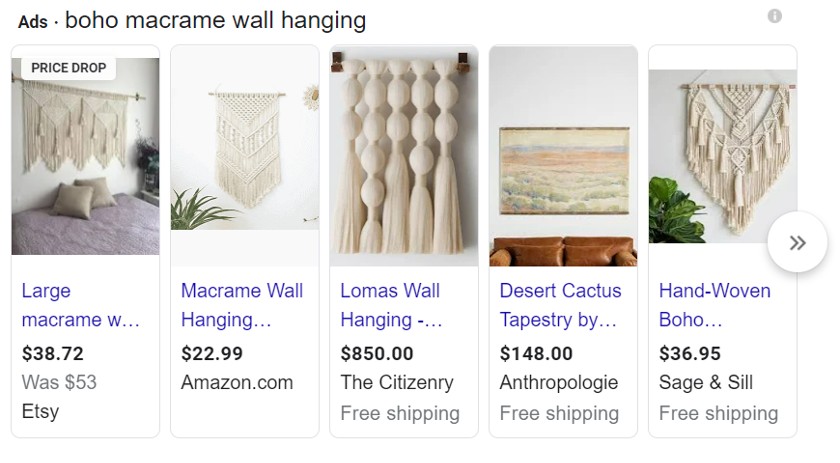
A Google search for this keyword brings up shopping ads at the top of the results page.
For more info, read our guide to boosting your business through Google advertising through advertising on Google.
Search engine optimization (SEO) helps your website rank higher in online search results. SEO tactics are crucial to ecommerce success, seeing as a widely reported stat says roughly 68% of online experiences begin with a search engine.
SEO can get complicated—it shapes how you structure your product descriptions, image files, title tags, meta descriptions, and more. Your search engine rankings take over 200 factors into account, but you don’t have to tackle them all to be successful in your niche.
Start by carefully identifying your chosen keywords and working them into your site’s content. Then, use your ecommerce platform’s site builder to carve out effective title tags, meta descriptions, and headers. Read our beginner’s guide to ecommerce SEO to learn more.
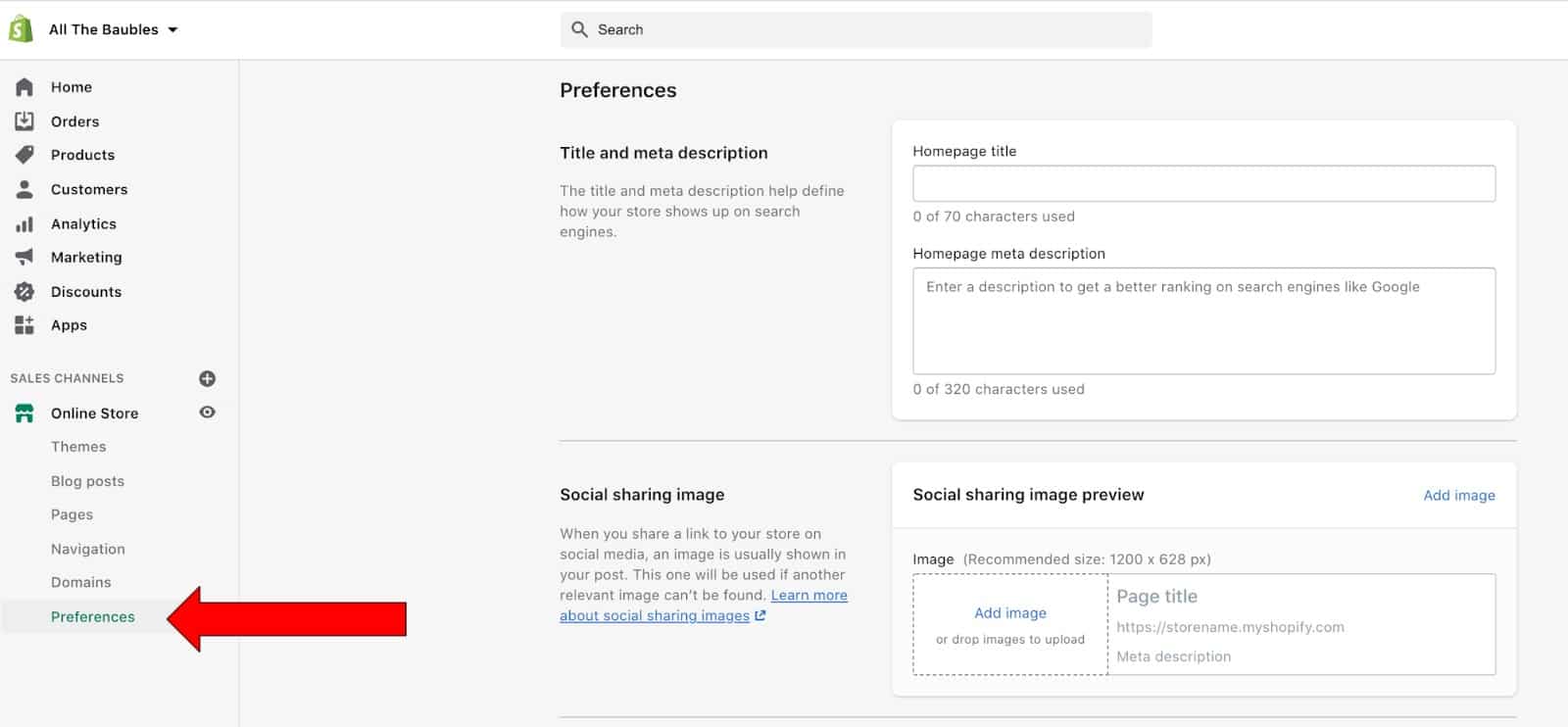
Dial in SEO tactics on your Shopify store by navigating to the Preferences tab. (Source: Shopify)
Whether your site is product- or content-focused, adding appropriate content to your marketing plan is an effective way to build a long-term traffic stream. It also benefits your SEO, nurtures brand recognition, and can help grow your contact list.
Content marketing can be done by creating a few blog posts about your niche, starting a YouTube channel, recording a podcast, or adding custom infographics to your site.
If you don’t have the means to create content yourself, try seeking help from a freelance professional on Fiverr. Alternatively, you can work with established content creators to score guest spots on their media channels. Any amount of content is a useful tool to get the word out about your store.
Personally reaching out to those interested in your niche is a great way to get attention as you’re starting a dropshipping business. It is especially effective if your concept appeals to those in active, engaged communities.
Niche communities exist on thousands of Facebook groups, online forums, and Reddit pages. Members of these groups are enthusiasts who love to talk shop, which often includes discussing products and sources (like your new store).
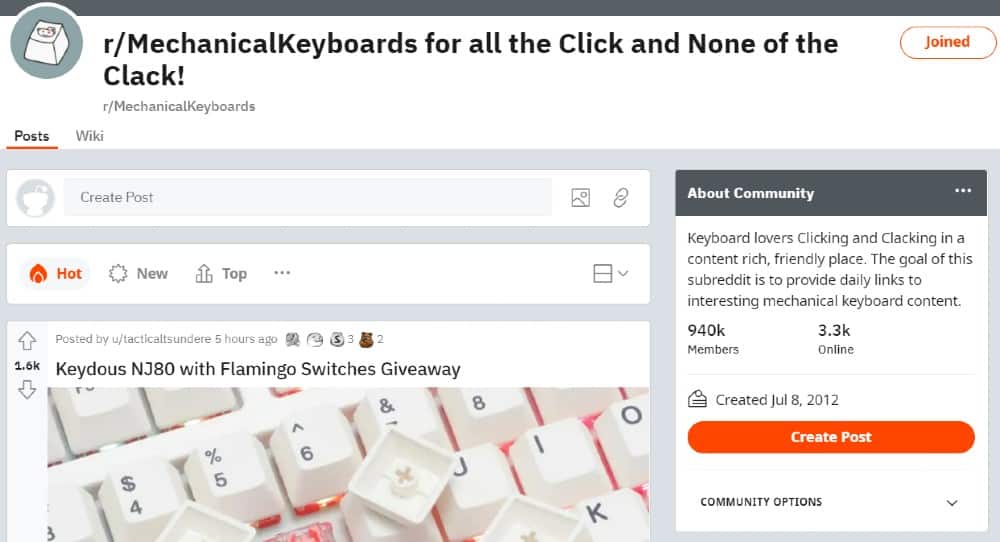
The mechanical keyboard Reddit community has 940k members, with thousands online at any given time. (Source: Reddit)
These audiences are welcoming to like-minded participants, but they usually don’t respond to intrusive sales techniques in their spaces.
Try building rapport with these communities by leveraging your own knowledge of your niche. Build relationships, start conversations, offer advice, and post reviews. While engaging with other members, you can mention your store or recommend some of your products.
When done tactfully, community involvement can build trust for your brand from well-qualified customers.
Step 10: Run Your Dropshipping Store
Running your dropshipping store mainly comes down to overseeing your orders, serving your customers, and basic accounting. Then, as your business develops, another task is to use analytics to refine your offerings and find ways to drive growth (and make more money).
Here’s what the duties of a dropshipping store owner look like:
If you’re using dropshipping marketplaces, order management and fulfillment is a hands-off process, but you’ll need to keep an eye on it. Your ecommerce platform dashboard will report new, processing, and shipped sales; if any orders sit unshipped too long, follow up with an inquiry to your supplier.
Fostering relationships with your vendors is important to scaling your business. As your business grows, you may want to move away from dropshipping marketplaces and source your products directly for greater margins. Stay in good standing with your suppliers and keep communication professional.
Keep an eye on your communication channels listed on the “Contact Us” page of your website. Depending on how much time you have to dedicate to your business, you can either respond to queries as they come in, or set aside a time each day (or few days) to catch up.
As your orders increase, so will customer service needs. Be prepared—it’s a standard part of owning an online business. If customer support tasks require more time than you can provide, consider hiring part-time help or outsourcing to a third-party service provider.
As a startup dropshipping venture, your accounting responsibilities will be minimal. It’s still crucial to keep track of the money that comes in and out of your business (including sales tax) and keep up on your licensing renewals and platform fees.
Another part of running a successful business is identifying ways to improve. Your ecommerce platform likely has analytics features that convert your store’s data into clear, helpful reports to help you get crucial insights, such as:
- Sales: Identify your best-performing channels, bestselling products, most popular categories, and where to put more ad spend.
- Shopper Behavior: Uncover whether more customers are buying on mobile or desktop, how they interact with your store, and who your best customers are.
- Profitability: Point out which products and variants are the most profitable, and evaluate what your sales and profits look like month over month.
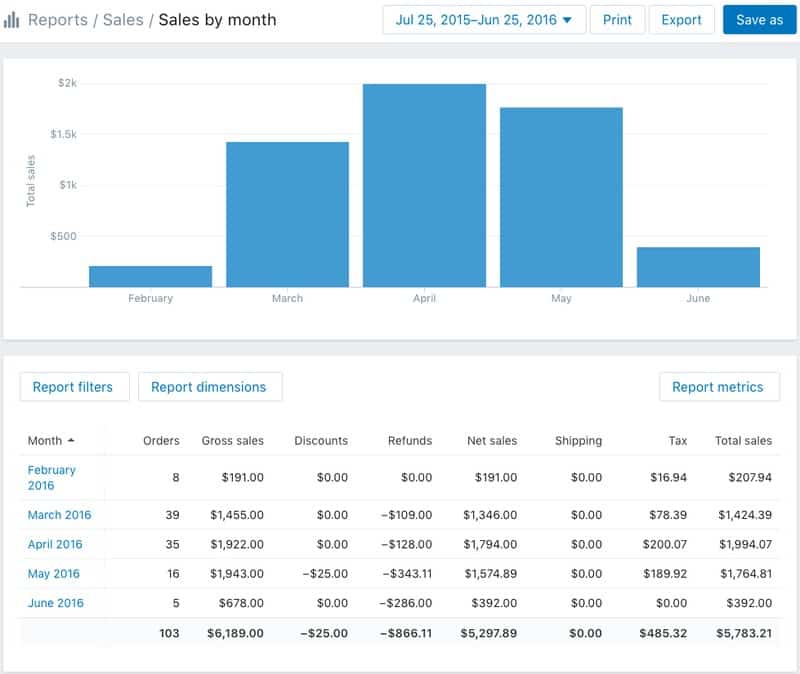
An example of Shopify’s sales reporting feature (Source: Zenstores)
To learn more about the top metrics and KPIs (Key Performance Indicators) you should monitor to improve your business, read our guide to retail analytics.
How to Start a Dropshipping Business Frequently Asked Questions (FAQs)
Dropshipping is an ecommerce business model in which the retailer acts as an online storefront where customers purchase goods. However, instead of the retailer fulfilling orders, they’re fulfilled by a third-party manufacturer or wholesaler.
This way, the dropshipper doesn’t keep the products in stock and instead acts as a facilitator between the customer and supplier. In many cases, the customers do not know they are receiving a dropshipped product.
It can be. Overhead costs are much lower for dropshipping compared to traditional ecommerce because there is no upfront investment in products. However, the profit margin on each individual sale is typically much lower—around 15%–20% compared to 40%–50%.
You can start a dropshipping business with less than $100 if you just want a simple setup. At a minimum, you’ll need a domain name, an online store, and a reliable internet connection.
However, you will also likely want to invest in product samples, which can cost up to several hundred dollars depending on the type and quantity of products you’re interested in.
Once you’re up and running, you’ll pay an ongoing ecommerce software fee ($30–$300 per month). To generate sales, you’ll also likely want to invest in social media and/or search engine marketing as well as content creation.
No. Many new and small dropshippers operate as a sole proprietorship. However, registering for an LLC reduces some elements of personal liability. If your business grows or you have high ambitions to scale, registering for an LLC is a wise choice.
The easiest items to dropship are typically trending or popular items, lightweight products (for low shipping costs), items that aren’t typically purchased brand name, or items that have a marketable niche.
Some of the best items to dropship include:
- Car accessories
- Phone cases and screen protectors
- Pet toys
- Office supplies
- Kitchen utensils
- Clothing
- Ring lights
- Ear Plugs
- Kitchen appliances
- Gaming headsets
- Hats
- Scalp massagers
- Face rollers
- Water bottles
- Camera tripods
Yes, dropshipping is a perfectly legal method for fulfilling ecommerce orders. But, as with any business, dropshippers need to follow all the rules and regulations set by local, national, and international authorities around selling goods.
Bottom Line
Starting a dropshipping business is a highly accessible way for sellers to seek a low-cost and low-risk entry into ecommerce. It’s flexible enough to work for part-time entrepreneurs and has the potential to earn a steady stream of real income. However, it often takes a few months for dropshipping stores to gain traction and be sufficiently profitable.
The initial investment of time can be hefty, but your store’s success relies on proper research, site building, marketing, and management.
Starting a dropshipping business is best done through Shopify and DSers, which integrate to make the process simple from start to finish.
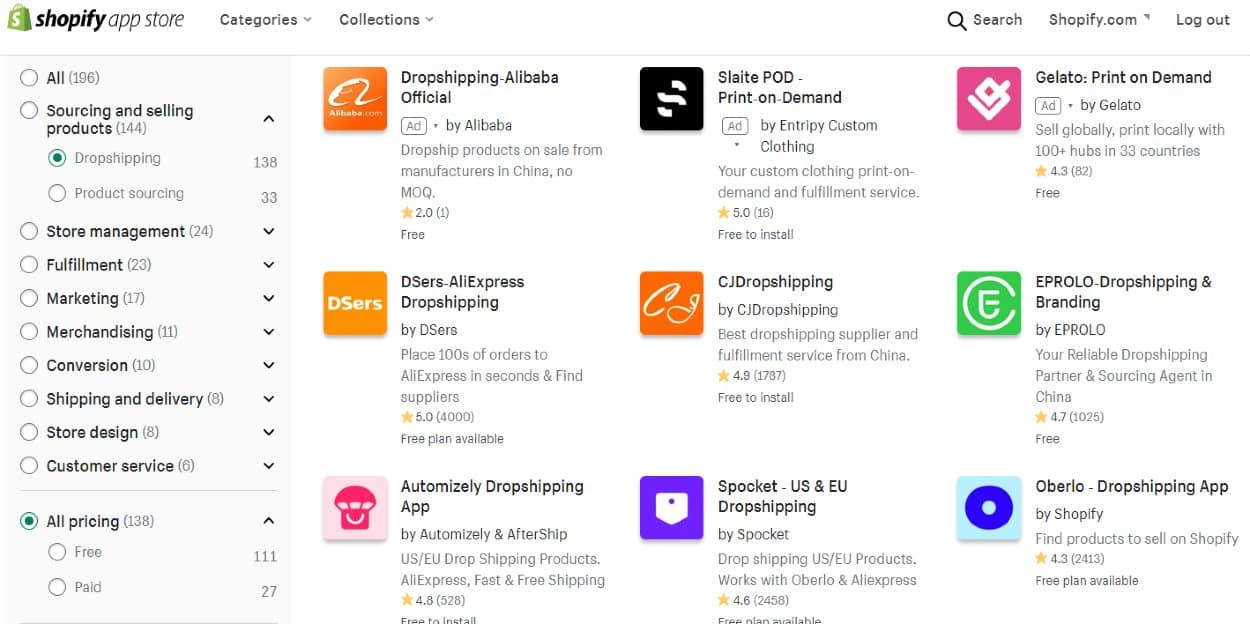
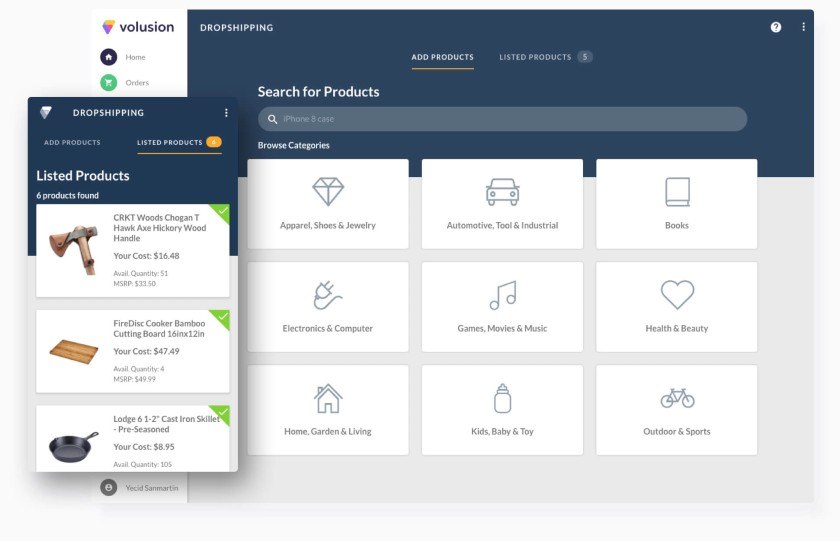
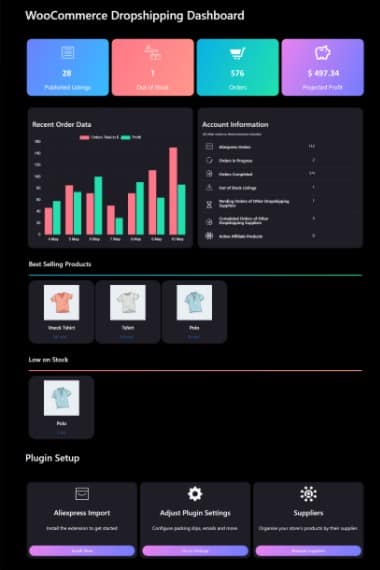
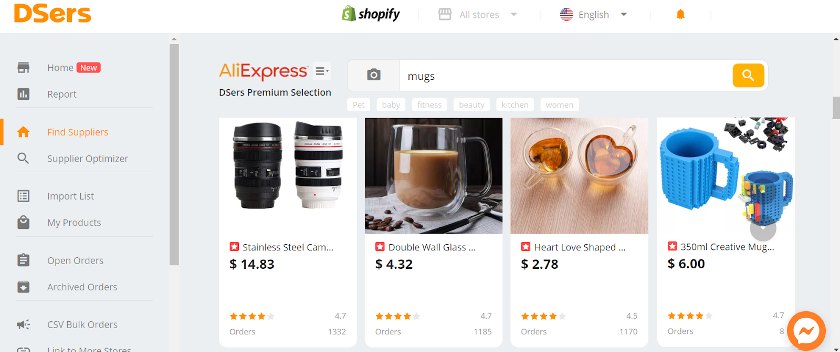
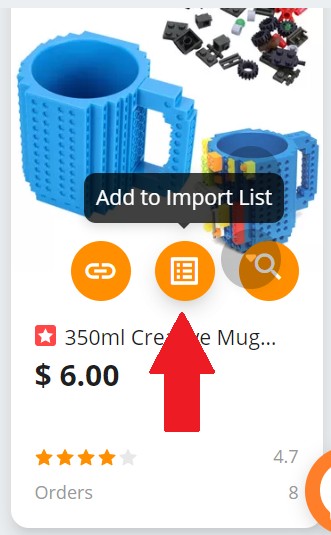
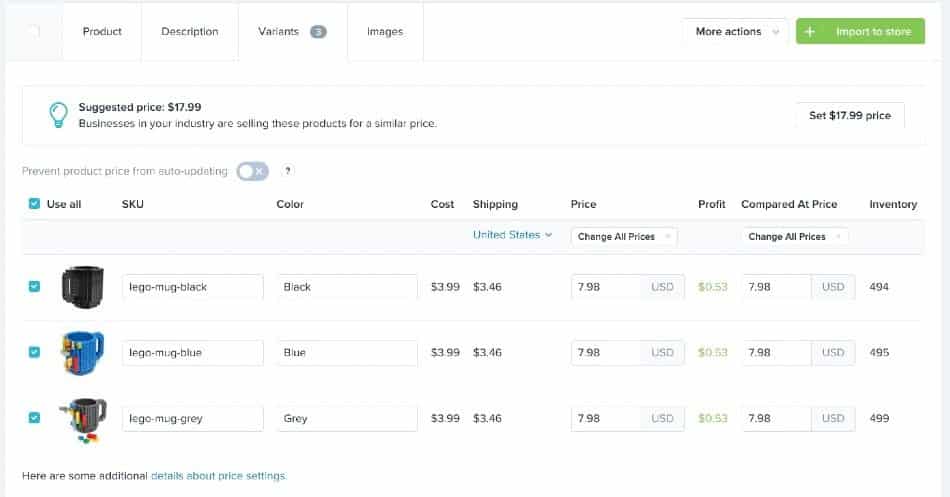

Create accounts for your business on Facebook, Instagram, and Pinterest and use them to promote your store through audience engagement and shoppable posts.
You can easily populate a Facebook Shop from your Shopify or WooCommerce product listings. Then, use those new listings to create posts and share across your personal network. Both Instagram and Pinterest let you create shoppable posts.
This method is a great approach to reach interested customers in their natural habitat. Plus, it reduces the steps for conversion, helps you gather data, and builds your online presence.
Take a look at the impact on the NY-based intimate wear brand The Natori Company: After creating shoppable Instagram posts and becoming active on Facebook and Twitter, the brand saw a 100% increase in revenue and a 1,416% increase in Instagram referral traffic to its website.
How shoppable Instagram posts work to refer traffic and create sales
(Source: Motion Ave)